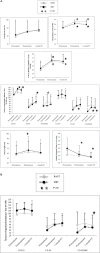Robot-assisted vs. sensory integration training in treating gait and balance dysfunctions in patients with multiple sclerosis: a randomized controlled trial
- PMID: 24904361
- PMCID: PMC4033226
- DOI: 10.3389/fnhum.2014.00318
Robot-assisted vs. sensory integration training in treating gait and balance dysfunctions in patients with multiple sclerosis: a randomized controlled trial
Abstract
Background: Extensive research on both healthy subjects and patients with central nervous damage has elucidated a crucial role of postural adjustment reactions and central sensory integration processes in generating and "shaping" locomotor function, respectively. Whether robotic-assisted gait devices might improve these functions in Multiple sclerosis (MS) patients is not fully investigated in literature.
Purpose: The aim of this study was to compare the effectiveness of end-effector robot-assisted gait training (RAGT) and sensory integration balance training (SIBT) in improving walking and balance performance in patients with MS.
Methods: Twenty-two patients with MS (EDSS: 1.5-6.5) were randomly assigned to two groups. The RAGT group (n = 12) underwent end-effector system training. The SIBT group (n = 10) underwent specific balance exercises. Each patient received twelve 50-min treatment sessions (2 days/week). A blinded rater evaluated patients before and after treatment as well as 1 month post treatment. Primary outcomes were walking speed and Berg Balance Scale. Secondary outcomes were the Activities-specific Balance Confidence Scale, Sensory Organization Balance Test, Stabilometric Assessment, Fatigue Severity Scale, cadence, step length, single and double support time, Multiple Sclerosis Quality of Life-54.
Results: Between groups comparisons showed no significant differences on primary and secondary outcome measures over time. Within group comparisons showed significant improvements in both groups on the Berg Balance Scale (P = 0.001). Changes approaching significance were found on gait speed (P = 0.07) only in the RAGT group. Significant changes in balance task-related domains during standing and walking conditions were found in the SIBT group.
Conclusion: Balance disorders in patients with MS may be ameliorated by RAGT and by SIBT.
Keywords: motor skills disorders; physiological adaptations; postural balance; proprioception; sensory feedback.
Figures


References
-
- Benedetti M. G., Gasparroni V., Stecchi S., Zilioli R., Straudi S., Piperno R. (2009). Treadmill exercise in early multiple sclerosis: a case series study. Eur. J. Phys. Rehabil. Med. 45, 53–59 - PubMed
LinkOut - more resources
Full Text Sources
Other Literature Sources
Medical

